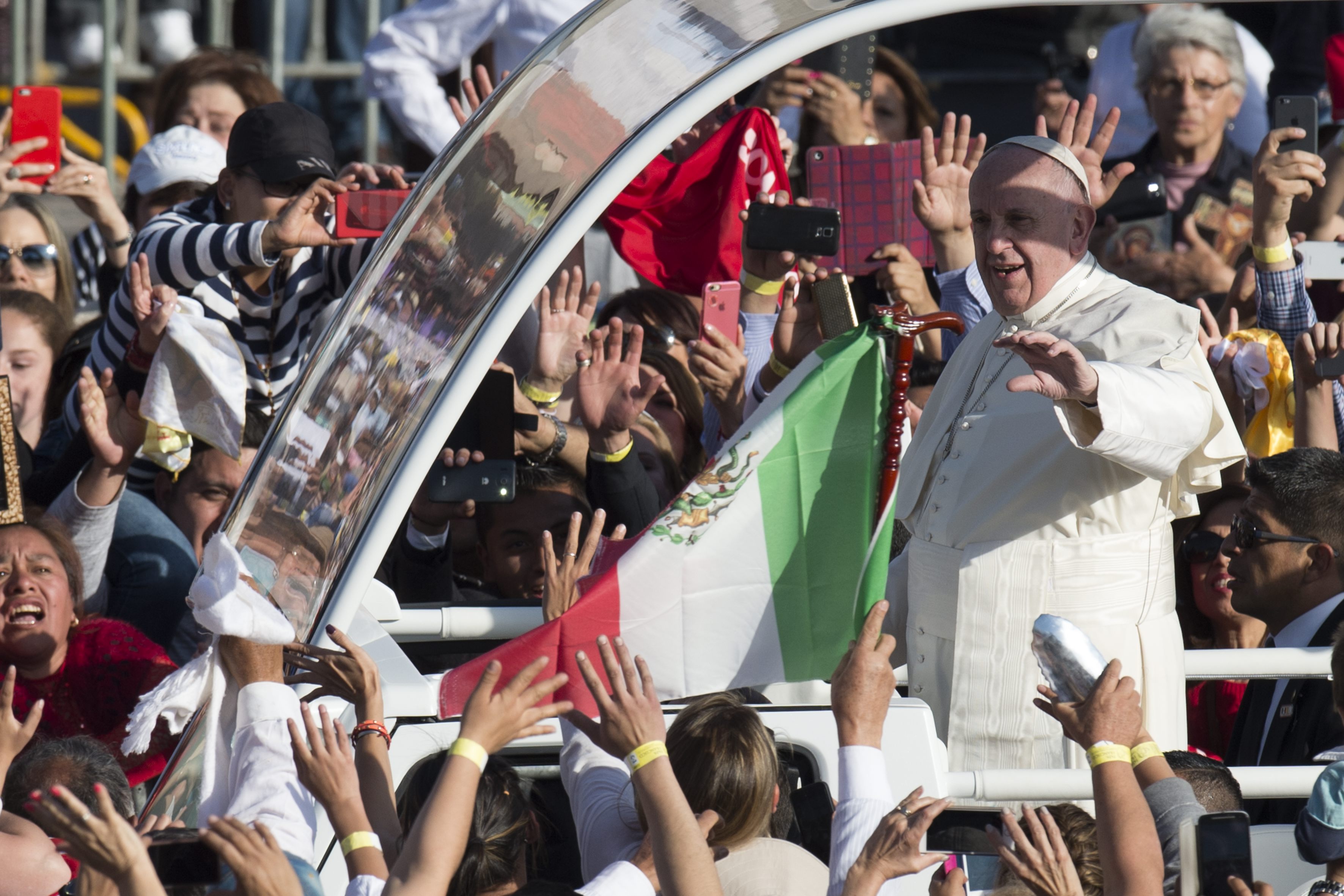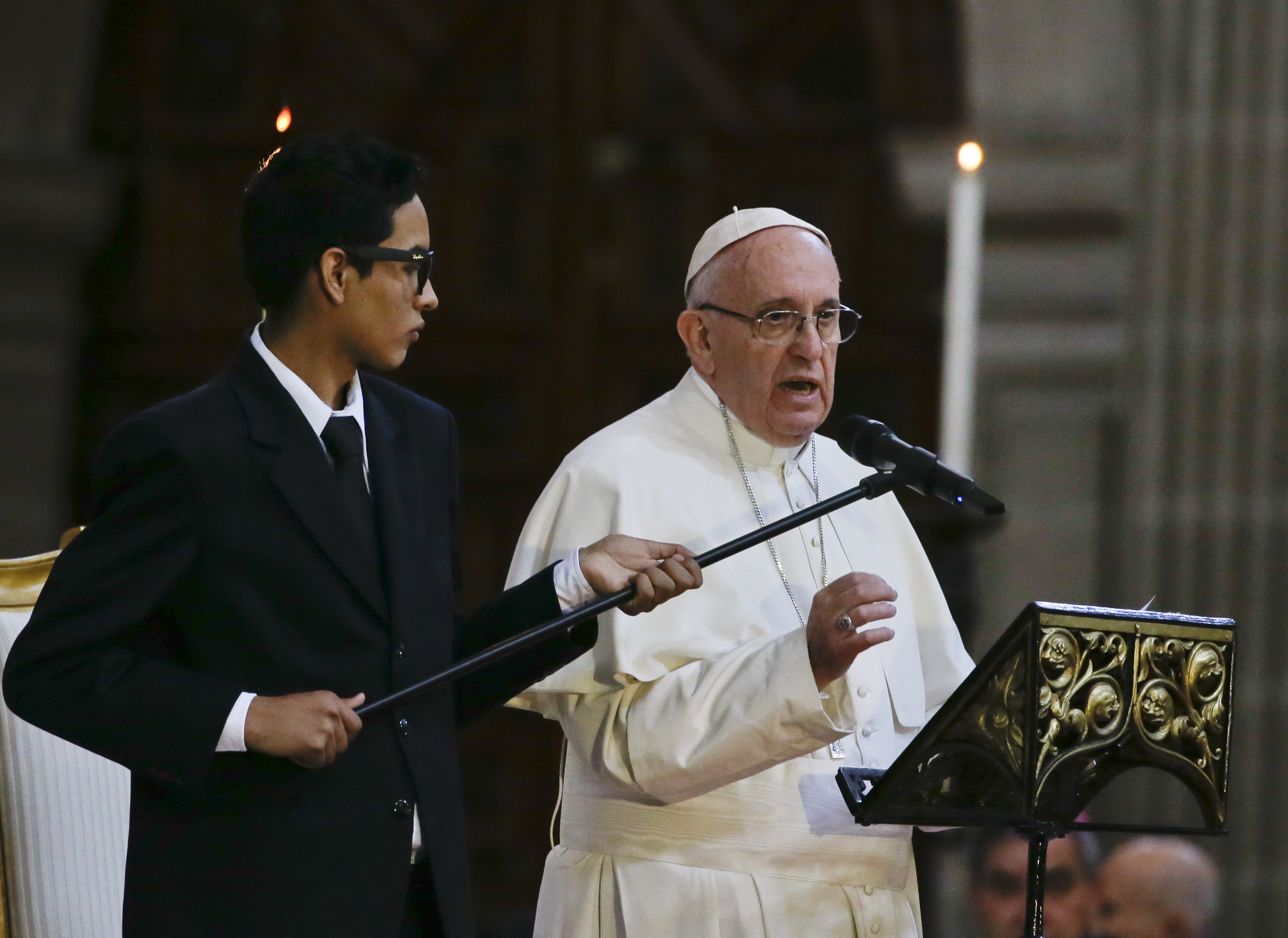Pope Francis Will Finish His Mexico Trip at the Edge of the Rio Grande
By Travis Putnam Hill
Reporting Texas

Pope Francis waves to well-wishers as he arrives at the Basilica of the Virgin of Guadalupe in Mexico City. (L’Osservatore Romano/Pool Photo via AP)
For Reporting Texas
When Pope Francis ends his travels through Mexico in the northern border city of Juarez on Wednesday, hundreds of thousands of people are expected to greet him along his route and attend Mass just a stone’s throw from the banks of the Rio Grande. Across the border, a similar influx of pilgrims will flow into the city of El Paso, and thousands of the faithful will gather at the University of Texas at El Paso’s Sun Bowl stadium to view a live stream of the Mass.
The multitudes gathering on either side of the border will witness the culmination of a papal visit laden with symbolic political messages for a Mexico grappling with near-pandemic violence and corruption.
But the pope’s visit to the border region is not only about highlighting Mexico’s social and political affairs. It’s also an opportunity for Catholics from across North America to express their faith, while others see to advance their causes in the presence of the pontiff.
Pablo López is the president of the South Side Neighborhood Association in El Paso, a group whose community abuts the international boundary.
“The community is preparing for the greatest event in some of our lifetimes,” López said. “It’s going to be an event that some of us will never see again or hear about again.”
Júarez traffic officials expect 216,000 people to attend Mass Wednesday afternoon at the old fairgrounds next to the Benito Juárez Olympic Stadium. The stadium is across the Rio Grande, not far from López’s South El Paso neighborhood of Segundo Barrio, one of the city’s oldest and poorest residential areas.
The Diocese of Juárez has called upon members of the Catholic community to form a human fence, or “valla,” along the pope’s route from the airport to the Mass area early Wednesday. Church officials said an estimated 60,000 people were needed for the effort; 25,000 of the volunteers who signed up were from the United States, according to the El Paso Times.
El Paso resident Mae Zaragoza, 45, is one of about 750 volunteers (150 from El Paso, according to the El Paso Times) who have trained to provide first aid to members of the human fence should they need it.
Zaragoza has been volunteering since the second week of January to help the Diocese of El Paso with the vast amount of miscellaneous logistical work needed to prepare for this event.
“I take this opportunity and this historic event very personally,” she said. “I see this as a service.”

In remarks at a Mexico City cathedral, Pope Francis challenged the Catholic hierarchy to help Mexicans escape the violence and corruption plaguing their nation. (Gregorio Borgia/AP Photo)
She said the pope’s visit is particularly meaningful for Juárez, a city whose violent reputation often overshadows the lives of the people who inhabit it.
“He stands for peace,” she said of Francis. “And having someone standing for peace and coming to the community means a great deal for them.”
For those who aren’t making the border crossing, the Diocese of El Paso has organized a live telecast of the papal Mass at the 50,000-seat Sun Bowl stadium, an event that is drawing Catholics from throughout the U.S.
High school teacher Laura Adauto, 60, an El Paso native, is flying in from San Jose, Calif., to attend the “Two Nations, One Faith” event at the Sun Bowl.
“I am so excited that he is going to this part of the land where my grandparents were from. How could I not go? I am going back to my roots,” said Adauto, who moved away 20 years ago.
Adauto’s aunt Loretta Knight, also an El Paso native, is flying in from Tyler, where she works as a bilingual substitute third-grade teacher. She will be there with a sister who lives in El Paso. Knight said her sister called her from the ticket line to see if she wanted a ticket.
“It is just very touching that [the pope] picked Juárez. He picked places that he believed need to be set free,” Knight said.
The Papal Pilgrimage
Before reaching the U.S.-Mexico border, the pope will travel a route that takes him through several other regions that embody some of Mexico’s most significant troubles.
On Sunday, Francis arrived in Ecatepec, an industrial suburb of Mexico City where the kidnappings and murders of thousands of girls — most between the ages of 10 and 17 — since 2005 have sparked protests. He will then travel south to Chiapas, home to one of Mexico’s largest concentrations of indigenous people, and then on to Morelia, the capital of Michoacán, a state besieged by drug-gang violence and birthplace of large numbers of Mexican immigrants to the U.S.
Francis’ trip to Mexico — which follows his historic meeting in Cuba with Russian Orthodox Patriarch Kirill on Friday — concludes in Juárez on Wednesday. His choice of Ciudad Juarez is expected to draw attention to immigration concerns, as Juarez/El Paso is a major gateway for immigrants as well as commerce. El Paso and Juárez make up one of the largest international border metroplexes in the world, and the border crossings are some of the busiest in North America. In 2014, more than 9.1 million personal vehicles, 6.1 million pedestrians, and 330,000 loaded truck containers entered the U.S. through El Paso, according to the U.S. Bureau of Transportation Statistics.
Juarez is recovering from a decade of cartel violence, killings of women that often go unpunished, and notoriety as one of the most murderous cities in the world. In Juarez, Francis will visit Cereso Prison No. 3, one of Mexico’s largest prisons and a former symbol of gang power. In 2009, a battle between rival gangs left at least 20 inmates dead inside the prison. He will also meet with industrial and labor leaders and with workers.
If not for the border fence cutting the metropolis in two, El Paso and Juárez might appear as one unified community — and in some ways they do, with hundreds of residents crossing the border daily for work or school and families spanning both sides of the border. Yet the sister cities are marked by stark divides: The violence that has gripped Juárez over the past decade has not marred El Paso, whose inhabitants often say it is “one of the safest cities in the U.S.,” a ranking that has been supported in recent years by independent research firm CQ Press.
Organizations in El Paso, which is more than 80 percent Hispanic, are using the pope’s visit to the region to draw attention to the plight of immigrants. The Border Network for Human Rights erected a banner along the border fence, reaching the height of the wall and visible from both sides, that reads“#ImmigrantLivesMatter” to protest the separation of families and what the group alleges is the U.S. government’s militarization of the border.
Claudia Taylor, a community organizer for The Texas Civil Rights Project labor justice committee, hopes that Francis’ visit raises awareness about the issues affecting migrant workers.
The labor justice committee wrote a letter to the pope informing him of the situation migrants face when they arrive in the U.S., Taylor said. Workers have been victims of wage theft and labor trafficking, she said. Many people from Mexico and Central America are promised jobs in restaurants, construction or housekeeping in the U.S., she said, but end up not being paid and sometimes enslaved by labor traffickers once they make it across the border.
Taylor hopes that the pope’s message from Juárez will resonate with people even after the excitement of his visit dissipates.
“It’s a message of love and respect and dignity, and that’s how we should treat each other all the time,” she said.
El Paso Prepares for Throngs of Visitors
Though Francis is not expected to set foot on U.S. soil, his message will be heard loud and clear in El Paso for both attendees at the Sun Bowl and those hoping to catch a glimpse of the pontiff from across the border fence.
The City of El Paso has taken measures, however, to discourage crowds from forming along the barrier.
Security plans are based on an estimate of as many as 500,000 people visiting the El Paso area, said Sgt. Robert Gomez of the El Paso Police Department.
With so many visitors anticipated, security operations are being shared among multiple law enforcement agencies, including El Paso police, El Paso County Sheriff’s Office, United States Customs and Border Protection and the Texas Department of Public Safety.
Schools in the El Paso, Gadsden, Ysleta and Socorro districts are closing for the pope’s visit.
Officials of the El Paso Independent School District said they would bring students in Monday, the President’s Day holiday, to make up for the lost day,
In preparation for the anticipated large audience at the Sun Bowl, officials at the University of Texas at El Paso said the school would be closed except for critical support personnel and the UTEP Police Department.
Points of entry along the border will have extended operating hours the week of the pope’s visit. From the Monday before the pope’s visit through Friday, the Santa Teresa point of entry, which usually closes at midnight, will be open 24 hours a day for pedestrians and passenger vehicles. The Tornillo-Guadalupe international bridge will be open 24 hours a day from Wednesday through Friday.
But some roadways and South Side communities will be closed to traffic. Police will close about 9.5 miles of the Border Highway and parts of the Segundo Barrio and South-Central neighborhoods.
Gomez said that the police decided to close the area due to safety concerns.
“The main reason was to protect the neighborhoods … from an influx of people in those areas,” Gomez said.
Pedestrian traffic will be allowed to enter the area across from the Mass venue, but vehicle traffic will be limited to residents and business employees, who must pass through a single checkpoint. Few people will be allowed to enter or exit the area for the duration of time the pope is in the Mass area in Juárez.
“The officers will obviously have a large amount of discretion and will have to determine if the person lives there on a case-by-case basis,” Gomez said.
A number of businesses in the area, including the iconic Bowie Bakery, will be closed on the day of the pope’s visit to Juárez. Other businesses, like Nachita’s Grocery, are playing it by ear — their owners will decide whether to stay open when the day comes.
Despite the limited access to the south side communities, Pablo López and his neighborhood association in Segundo Barrio will receive visitors from near and far.
“We are going to have a friendly walking area here for anybody who wants to join us from other parts of the city or the state or the country,” he said. “We welcome them with open arms.”
Anna Casey, Estefania Espinosa, Austin Hamby, Miranda Mason, Swathi Narayanan and Jacqueline Sanchez contributed to this report.